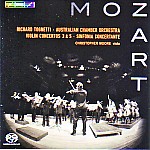In most respects these are extremely compelling, stylish performances, but they nevertheless earn only a guarded recommendation. Tempos are lively, but never to the point that the music sounds breathless. The ensemble’s unanimity is matched by characterful articulation, even in such simple matters as the triplet accompaniment of the Third violin concerto’s slow movement. The fun bits, such as the “Turkish” interlude in the finale of the Fifth concerto, are marvelously bracing. Richard Tognetti proves himself a consistently imaginative conductor and soloist, ornamenting the melodic line interestingly, and he plays a mean cadenza. In the Sinfonia concertante violist Christopher Moore matches him note for note (and has a fetchingly dusky timbre to boot).
As so often in period-influenced performances, however, the problem concerns the vibrato issue (or timbre more generally). Tognetti himself contributes an intelligent note in which he admits the impossibility of recreating a performance of Mozart’s day, while still opting for gut strings and period-style performance practice. To his credit, he does not offer the sort of expressively minimalist vivisection typical of many period-instrument groups. That said, Tognetti would not have raised the issue had he not intended to make a point of the approach, and in this respect his choices strike me as too expressively limited. The result simply isn’t as attractive as it should be. The lack of warmth to the tone makes the sharply etched rhythms, normally a big plus, tend toward the cold and mechanical.
The oft-repeated HIP mantra that vibrato was an “ornament” in Mozart’s day won’t wash here. That’s not the issue, and even if it were, as early as the 1720s we have English diarist Roger North noting concerning vibrato that violinists “who use it well never let a note rest without it…” However, while vibrato can indeed be used ornamentally, authorities as diverse as Geminiani and Leopold Mozart made a clear distinction between vibrato as an audible embellishment and the kind that simply improves the tone, and that’s the kind that I am discussing here.
It is a mistake to omit this sort of vibrato in both solo and ensemble playing on the basis of the fact that some authorities caution against excessive ornamentation. In other words, the question does not concern correct period style, but rather basic tone production. Carl Flesch states the issue very concisely and unequivocally: “Even the greatest violinistic genius will play out of tune without a leveling and corrective vibrato.” The reason for this phenomenon is explained by none other than Arnold Schoenberg, an authority sometimes cited (wrongly) as being opposed to the modern, “continuous” kind. In reality, this is precisely the type that Schoenberg favored, while he decried the sort of sentimental, excessive “ornamental” variety so often abused in his own day, in ours, and since time immemorial.
Schoenberg writes: “Whereas the ‘open’ string shuts off its far end with a hard, ‘stiff’ piece of wood, giving a ‘sharp demarcation’, in the case of the ‘stopped’ note this marking-off is done by the ‘soft’, ‘movable’ finger, giving less sharp demarcation. So absence of vibrato will not mean a pure tone, because of this indefinite demarcation. The note need not actually be out of tune, but its intonation is unconvincing. There will, in addition, be a vague tremor on the part of the finger. So to touch up the impurity of this lifeless tone one uses vibrato… This makes the tone ‘living’, ‘interesting’, ‘lively’, ‘warm’, and all the rest of it.” This observation is timeless: it has nothing to do with gut strings, short bows, chin rests, and the other particulars of authentic performance frequently used to excuse the absence of vibrato.
Schoenberg’s observation also explodes the HIP-promulgated myth that vibratoless playing results in a “pure” sound. In reality it does just the opposite. The longer a violin tone is sustained without vibrato, the greater the likelihood that it will strike the listener as out of tune. That is just what happens in Tognetti’s performances–not too often, and not drastically, but enough to become distracting on sustained notes, giving the music a rawness that Mozart surely would have decried because it’s a problem so easily solved in terms of fundamental violin technique. As Tognetti himself points out, Leopold Mozart was no radical–so if even he makes a point of this issue in his Violin School, there’s little excuse for modern performers not to take notice of the fact.
The degree to which this will bother you depends on how sensitive you are to such effects, and no doubt part of the ongoing vibrato controversy stems from individual differences in this regard. And of course, musicians are no different from anyone else when it comes to the ability to perceive subtleties of intonation. The sad thing is that if Tognetti and his admirable band really wanted to do what musicians in Mozart’s day did–freely use every means at their disposal to produce a beautiful, singing tone–we wouldn’t be having this conversation, and the interpretations probably would be far more authentic in spirit. In sum, I like everything about these performances except for how they actually sound.
































